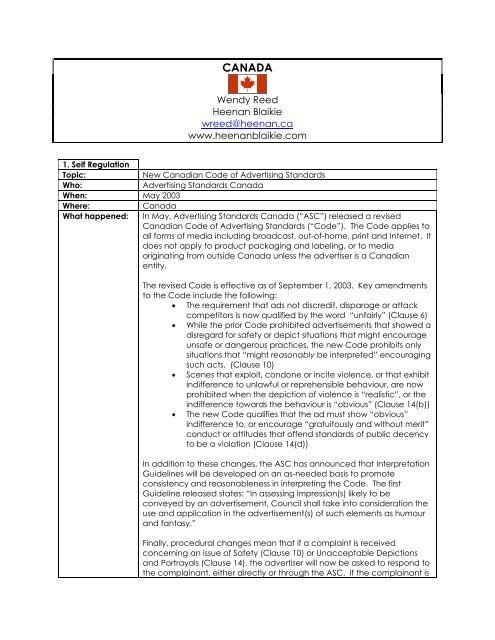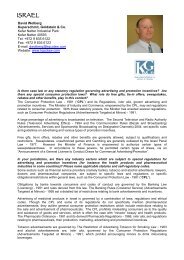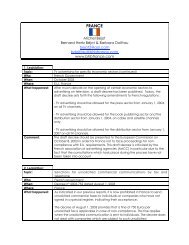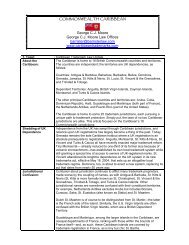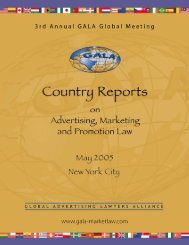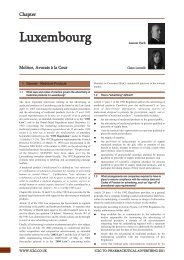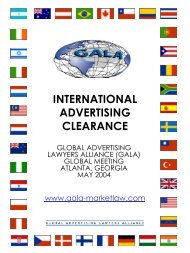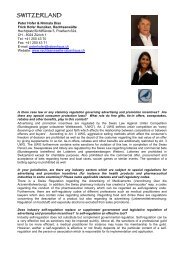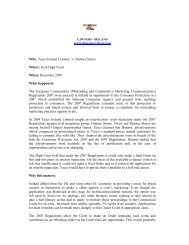Country Report - GALA
Country Report - GALA
Country Report - GALA
You also want an ePaper? Increase the reach of your titles
YUMPU automatically turns print PDFs into web optimized ePapers that Google loves.
CANADA<br />
Wendy Reed<br />
Heenan Blaikie<br />
wreed@heenan.ca<br />
www.heenanblaikie.com<br />
1. Self Regulation<br />
Topic: New Canadian Code of Advertising Standards<br />
Who: Advertising Standards Canada<br />
When: May 2003<br />
Where: Canada<br />
What happened: In May, Advertising Standards Canada (“ASC”) released a revised<br />
Canadian Code of Advertising Standards (“Code”). The Code applies to<br />
all forms of media including broadcast, out-of-home, print and Internet. It<br />
does not apply to product packaging and labeling, or to media<br />
originating from outside Canada unless the advertiser is a Canadian<br />
entity.<br />
The revised Code is effective as of September 1, 2003. Key amendments<br />
to the Code include the following:<br />
• The requirement that ads not discredit, disparage or attack<br />
competitors is now qualified by the word “unfairly” (Clause 6)<br />
• While the prior Code prohibited advertisements that showed a<br />
disregard for safety or depict situations that might encourage<br />
unsafe or dangerous practices, the new Code prohibits only<br />
situations that “might reasonably be interpreted” encouraging<br />
such acts. (Clause 10)<br />
• Scenes that exploit, condone or incite violence, or that exhibit<br />
indifference to unlawful or reprehensible behaviour, are now<br />
prohibited when the depiction of violence is “realistic”, or the<br />
indifference towards the behaviour is “obvious” (Clause 14(b))<br />
• The new Code qualifies that the ad must show “obvious”<br />
indifference to, or encourage “gratuitously and without merit”<br />
conduct or attitudes that offend standards of public decency<br />
to be a violation (Clause 14(d))<br />
In addition to these changes, the ASC has announced that Interpretation<br />
Guidelines will be developed on an as-needed basis to promote<br />
consistency and reasonableness in interpreting the Code. The first<br />
Guideline released states: “In assessing impression(s) likely to be<br />
conveyed by an advertisement, Council shall take into consideration the<br />
use and application in the advertisement(s) of such elements as humour<br />
and fantasy.”<br />
Finally, procedural changes mean that if a complaint is received<br />
concerning an issue of Safety (Clause 10) or Unacceptable Depictions<br />
and Portrayals (Clause 14), the advertiser will now be asked to respond to<br />
the complainant, either directly or through the ASC. If the complainant is
not satisfied with the advertiser’s response, then the matter will continue<br />
through the traditional ASC complaint process. If the complainant is<br />
satisfied, the matter will not proceed further.<br />
Comment: The revisions to the Code, as well as the development of Interpretation<br />
Guidelines, are important in allowing advertisers both more flexibility and<br />
greater certainty with respect to how the ASC will apply the Code. The<br />
new procedure for complaints about Safety and Unacceptable<br />
Depictions and Portrayals has the potential to lead consumers to a better<br />
understanding of the advertiser’s position, and may encourage<br />
advertisers to be more directly accountable to consumers.<br />
2. Industry<br />
Guidelines<br />
Topic: Canadian Guidelines With Respect to the Sale and Marketing of<br />
Diamonds, Colour Gemstones and Pearls<br />
Who: Jewellers Vigilance Canada Inc.<br />
When: August 2003<br />
Where: Canada<br />
What happened: The Canadian Guidelines With to the Sales and Marketing of Diamonds,<br />
Coloured Gemstones and Pearls have been revised. These Guidelines,<br />
endorsed by the Competition Bureau, address definitions and terminology<br />
for use in advertising and sale of diamonds, coloured gemstones and<br />
pearls. These Guidelines are to be followed with respect to any<br />
representation, in any media, regarding these items.<br />
It is contrary to the purposes of the Guideline: (a) to make a<br />
representation that does not confirm in all respects to these Guidelines in<br />
the selling, advertising, or distribution of any substance defined in these<br />
Guidelines; or (b) to make any misleading or deceptive statement,<br />
representation or illustration relating to origin, formation, production,<br />
condition or quality of any substance defined in these Guidelines. Some<br />
examples of the guidance provided by this document are as follows:<br />
• It is contrary to the purpose of the Guidelines to refer to any<br />
diamond or coloured gemstone to identify any substance that<br />
has been partly or wholly created through human intervention.<br />
Such items must be identified as synthetic, composite,<br />
assembled, artificial, imitation, or simulated, as appropriate.<br />
This qualification must immediately precede the word<br />
diamond or coloured gemstone. Neither phrase may be<br />
given greater prominence or emphasis, or may be separated<br />
from each other.<br />
• The term “carat”, in reference to diamonds, may not be used<br />
where it could be presumed to refer either to karat weight or<br />
precious metal quantity.<br />
• It is unacceptable to use the word “perfect” to refer to any<br />
attribute of a pearl, cultured pearl, coloured gemstone or<br />
diamond.<br />
• With respect to coloured gemstones, the term semi-precious<br />
should not be used in any context.<br />
Comment: These Guidelines complement those established in the Canadian
Diamond Code of Conduct, as well as other general restrictions<br />
respecting advertising, sales and warranties under the Competition Act.<br />
They are applicable to all those engaged in the sale and advertising of<br />
coloured gemstones, diamonds and pearls in Canada.<br />
3. Industry<br />
Regulation<br />
Topic: Internet Advertising Guidelines<br />
Who: Competition Bureau<br />
When: February 2003<br />
Where: Canada<br />
What happened: The Canadian Competition Bureau has released guidelines concerning<br />
the application of the Competition Act to advertising on the Internet (the<br />
“Guidelines”). The Guidelines provide some practical insights on the<br />
Bureau’s approach to misleading representations and deceptive<br />
marketing practices on the Internet. Under the Guidelines, the Internet is<br />
treated no differently than any other media with respect to the<br />
application of the Competition Act. Therefore, the same prohibitions<br />
against false or misleading advertising will apply. The Guidelines,<br />
however, provide further details with respect to how the Act will be<br />
applied to this medium. For example:<br />
• Disclaimers and text hyperlinks leading to information relevant<br />
to an offer or claim should be very explicit, and accessible to<br />
all users, regardless of the software or hardware used to<br />
access the webpage;<br />
• Attention-grabbing tools, such as flashing text, cannot be used<br />
to draw the consumer’s attention away from a disclaimer;<br />
• Illustrations, photography, and/or artwork should fairly and<br />
accurately illustrate the product or service being offered;<br />
• Websites should not create a false or misleading impression as<br />
to the company’s location, identify or affiliation.<br />
The application of the Guidelines will be based on the test of general<br />
impression, and will be interpreted on a case by case basis.<br />
The Competition Bureau also states that it will: “Assert Canadian<br />
jurisdiction over foreign entities to the fullest extent authorized by law<br />
whenever necessary to protect the Canadian market from misleading<br />
representations and deceptive marketing practices”.<br />
Comment: The Guidelines go into great detail with respect to examples of permitted<br />
and restricted practices. With respect to international compliance, no<br />
doubt the Competition Bureau will be reliant upon cross border cooperation<br />
in order to enforce its Guidelines on extra-territorial advertisers.<br />
4. Regulations: Natural Health Products Regulations, Food and Drugs Act (“FDA”)<br />
Topic: New regulation of natural health products (includes “dietary<br />
supplements”)<br />
Where: The Canadian Federal Government (Natural Health Products<br />
Directorate)
When: June 18, 2003<br />
What happened: The final Natural Health Product Regulations (“NHPR”) of FDA were<br />
published on June 18, 2003 but will not come into force until January 1,<br />
2004 (except for the 60 day monograph approval process which starts<br />
July 1, 2004). The NHP Directorate (“NHPD”) is developing key information<br />
for NHPR compliance but little information is currently available. Other<br />
FDA regulations are the food, drugs, cosmetics and medical devices<br />
regulations.<br />
The NHPR will apply to NHPs as of 01/01/04, except where specific<br />
transitional periods for compliance apply with respect to product<br />
licensing, site licensing, good manufacturing practices (“GMPs”) and<br />
labeling requirements of NHPs, notably:<br />
• A product that has a drug identification number issued under the<br />
FDA drug regulations and falls within the NHP definition, has 6 years to<br />
comply with the NHPR (ending December 31/09);<br />
• Those who manufactured, packaged, labeled, imported NHPs before<br />
01/01/04, have 2 years ending December 31, 2005 to meet the NHP<br />
site license/GMP requirements.<br />
During the transition periods, the FDA drug regulations apply.<br />
NHPs will be regulated as a subset of drugs and must be pre-cleared,<br />
either by the 60 day monograph approval process or by providing other<br />
evidence to support the claim.<br />
Foreign and domestic site license applicants may submit a GMP<br />
compliance report from their own qualified Quality Assurance (“QA”)<br />
person in place of government inspectors. The NHPD will develop<br />
agreements with foreign regulators to establish GMP equivalence<br />
between countries.<br />
NHPs must make permitted health claims: structure-function claims riskreduction<br />
claims or therapeutic claims (cure/treatment of a disease).<br />
(Notably, US dietary supplements must not make treatment claims which<br />
may pose a challenge for North American packaging as the NHPR will<br />
permit treatment claims). Currently there are no proposed NHP<br />
advertising guidelines.<br />
Comment: The NHPR will have a significant impact on the NHP industry in Canada<br />
with some smaller entities struggling to comply, while larger, international<br />
entities focus on meeting the challenge of integrating the NHPR into their<br />
NHP international labeling and marketing plans.<br />
5. Discussion<br />
Paper:<br />
Options for Amending the Competition Act<br />
Topic: Strengthening the Civil Provisions of the Competition Act for Misleading<br />
Advertising<br />
Where: The Canadian Government---Competition Bureau<br />
When: June, 2003
What happened: The Competition Bureau issued a Discussion Paper for comment---Options<br />
for Amending the Competition Act. Key proposals in the advertising area<br />
include:<br />
• Increasing the current “administrative penalties” for misleading<br />
advertising/deceptive marketing practices from a limit of $100, 000 for<br />
a corporation and $50, 000 for an individual (or twice these amounts<br />
for subsequent violations) to an amount in the discretion of the<br />
Competition Tribunal based on the facts of each case.<br />
• Restitution: The courts would be empowered to order business and<br />
individuals who violate the misleading advertising provisions of the<br />
Competition Act and cause consumers loss, to provide restitution to<br />
consumers either by providing restitution directly to consumers from a<br />
restitution fund or by appointing a fund administrator to do so. The<br />
courts would have discretion in determining how any balance in the<br />
fund could be distributed including for example, giving it to non profit<br />
organizations that work to benefit consumers rather than returning it<br />
to the violator.<br />
• Civil Cause of Action: Those who suffer loss by misleading<br />
advertising/deceptive marketing practices would be entitled to seek<br />
damages in civil court. The Competition Act provisions currently<br />
limited to civil actions for criminal conduct (such as<br />
conspiracy/pyramid schemes) or breaches of Competition Bureau<br />
orders would be amended to facilitate such civil actions.<br />
Comment: The above represents a number of sweeping proposals that the Bureau<br />
had not previously signaled were coming. If these proposals are<br />
enacted, they will surely “up the ante” for misleading advertising in<br />
Canada.<br />
6. For Review and Proposed Competition Act Guidelines:<br />
Comment<br />
Topic: Guidelines on the Deceptive Notice of Winning a Prize Provisions,<br />
Competition Act<br />
Where: The Canadian Federal Government ---Competition Bureau<br />
When: August 26, 2003.<br />
What happened: The proposed guidelines to the Deceptive Notice of Winning a Prize<br />
provisions (“Prize Provisions”) of the Competition Act provide the<br />
following clarifications to key wording in the Prize Provisions:<br />
• Sending prize notifications by “electronic or regular mail or by any<br />
other means” includes mail, electronic mail, fax and door to door<br />
communications;<br />
• The reference to the recipient “doing a particular act” (to win a<br />
prize/benefit) refers to doing something positive rather than<br />
something passive (such as meeting residency/age requirements to<br />
enter a contest);<br />
• The reference to the recipient having to “incur a cost” to win a prize<br />
does not refer to an initial, incidental cost such as a stamp or to an<br />
amount that is nominal compared to the prize (i.e. the cost of getting
car insurance for a car prize). It would apply to having to call a 900#<br />
and incur costs to win a prize.<br />
Comment: The Guidelines to the Competition Act provisions on Deceptive Notice of<br />
Winning a Prize (“Prize Provisions”) clarify certain points in the provisions<br />
and generally track the Competition Act requirements for required<br />
disclosures in promotional contests and overall should be helpful.


